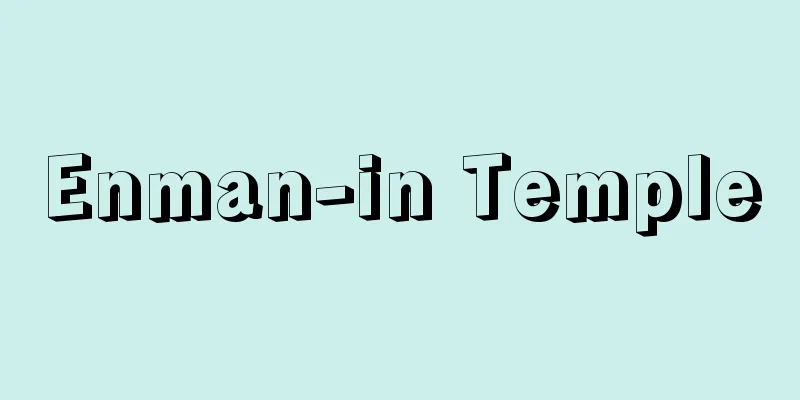Chimney - Chimney (English spelling)

|
This is a facility that releases combustion gases (smoke) generated by various combustion devices into the atmosphere from a high position. Its function is to prevent smoke damage to the inside of buildings, their surroundings, and the neighborhood, and to maintain good combustion by utilizing the ventilation force created by the temperature difference between the inside and outside of a tall vertical tube. The draft force of a chimney is based on the buoyancy caused by the difference between the weight of the gas in the chimney and the weight of the air around the chimney (this is called the chimney effect). The actual draft speed is the buoyancy minus the resistance of the chimney and flue. In order to provide a constant and reliable draft force, a fan is used to force air into the chimney. In ancient Greece and Rome, there were no chimneys, and smoke from furnaces was vented through holes in the roof. In medieval European homes, an inverted funnel-shaped tube was hung over the furnace in the kitchen or living room, with the end protruding above the roof to vent the smoke. This can be said to be the prototype of the chimney. It is said that fireplace chimneys, which move the furnace to the side of the wall and surround it on three sides with chimneys standing along the wall, were made in Italy around the mid-14th century. As masonry technology for stone and brick construction advanced, decorative chimneys of various shapes were made in European countries. Early chimneys were installed in large furnaces that burned logs, so they had large cross sections. After the 17th century, the use of coal increased, and fireplace chimneys became popular in ordinary people's homes. Fireplace chimneys were useful for ventilating homes because they promoted ventilation in the room, not just when heating was in progress. With the development of steam engines in the 18th century, chimneys were made specifically for boilers. The practice of lighting a fire at the base of a chimney and using the resulting draft to ventilate a building existed until the mid-19th century. In 17th century London, when fuel was largely shifting from wood to coal, the harmful smoke from factory and home chimneys caused social problems, and various countermeasures were considered and legal restrictions were put in place, but they had no significant effect until the Clean Air Act of 1956. This act effectively banned the use of fireplace chimneys. Tall chimneys dilute the smoke and distribute it over a wide area, so it is not a problem if the concentration is extremely low, but in areas downwind from industrial areas where many chimneys are concentrated, the concentration is dozens of times higher and causes smoke damage. The smoke damage is not much different from that caused by scattered low chimneys. [Masao Ishihara] materialChimneys are made of reinforced concrete, unreinforced concrete, steel, or assembled from cylindrical products such as galvanized steel sheets, asbestos pipes, concrete pipes, clay pipes, and ceramic pipes. In the past, masonry using bricks and stones was also commonly used, but it is rarely used today due to the large damage caused by earthquakes. Most large chimneys are made of reinforced concrete and steel, and reinforced concrete is particularly popular because of its long lifespan. The temperature of the exhaust smoke from these large chimneys can reach 120 to 600 degrees Celsius, so the inside of the lower part of the chimney, where the temperature is high, is lined with fireproof bricks. For small chimneys attached to small buildings such as houses, galvanized steel sheets or asbestos pipes with an inner diameter of about 6 to 12 centimeters are often used. For indoor heating stoves, galvanized steel sheets are often used because they can utilize the residual heat of smoke and are easy to process, assemble, and remove, while asbestos pipes are used for bath heaters and the like, as they have excellent thermal insulation and are advantageous in terms of lifespan. The temperatures at the points where the flues of these small chimneys pass through the wall can reach over 200°C, so spectacle stones or other fittings are installed to prevent the wall from getting too hot. [Shigeru Morinaga and Takashi Kuwahara] Source: Shogakukan Encyclopedia Nipponica About Encyclopedia Nipponica Information | Legend |
|
各種の燃焼装置から発生する燃焼ガス(煙)を高い位置から大気中へ放出する設備で、建物の内部や建物の周辺、近隣への煙害を防ぐことと、高い垂直筒の内外の温度差によって生ずる通気力を利用して良好な燃焼を維持することとがその機能である。 煙突の通気力は、煙突内ガスの重さと煙突周辺の空気の重さの差によって生ずる浮力に基づく(これを煙突効果という)。その浮力から煙突、煙道の抵抗を差し引いたものが実際の通気速度となる。一定で確実な通気力を与えるためには、送風機による煙突への強制押込み通気を行う。 古代ギリシア・ローマには煙突がなく、炉から出る煙は屋根にあけた穴から出された。中世ヨーロッパの住居では、台所や居室の炉の上に逆漏斗(ろうと)状の筒をつるし、先端を屋根の上へ出して排煙するようになった。これは煙突の原型といえよう。炉を壁際へ移し、三方を囲んで煙突を壁に沿って立ち上げた暖炉煙突は、14世紀なかばごろイタリアでつくられたという。石やれんがの組積造の技術が進むにつれて、ヨーロッパ諸国ではさまざまな形の装飾的な煙突ができた。初期の煙突は丸太を焚(た)く大きな炉に設けられていたので大きな断面をもっていた。17世紀以降、石炭の使用が増加し、庶民住宅に暖炉煙突が普及した。暖炉の煙突は、暖房時に限らず室の換気を促進する機能をもつので住居の換気に役だった。18世紀に蒸気機関が開発され、ボイラー専用の煙突ができた。煙突の底部で火を焚いて、その通気力を利用して建物の換気を行う方法は19世紀なかばまで存在した。 燃料が木材から石炭へ大きく転換した17世紀のロンドンでは、工場や家庭の煙突から出る煙の害が社会問題を引き起こし、さまざまな対策が考えられ、法的規制もなされたが、1956年の大気清浄法ができるまで大きな効果はあがらなかった。この法令によって暖炉煙突の使用は事実上できなくなった。高い煙突は煙を希釈して広い地域に分配させるから、その濃度がきわめて低い場合は問題にならないが、多数の煙突が集中する工場地域の風下になる地域では、その濃度が何十倍にもなって煙害を及ぼす。その煙害は、低い煙突が分散している場合とたいして変わらない。 [石原正雄] 材料煙突には鉄筋コンクリート造、無筋コンクリート造、鋼製(鋼造)のものや、亜鉛鉄板、アスベスト管、コンクリート管、土管、陶管などの筒状の製品を組み立てたものがある。古くはれんがや石を使った組積造もよく用いられたが、地震の場合の被害が大きいことなどから今日ではほとんど用いられない。大型の煙突の多くのものは鉄筋コンクリート造と鋼製であり、とくに鉄筋コンクリートのものは一般に寿命が長いことなどから多く用いられている。これらの大型煙突では排煙温度が120~600℃程度にもなるので、温度の高い煙突下部の内面に対して耐火れんがを用いた内張りなどをする。住宅などの小建築物に付属する小型の煙突では、内径が6~12センチメートル程度の亜鉛鉄板やアスベスト管がよく用いられる。室内の暖房用のストーブに対しては、煙の余熱が利用でき、加工、組立て、取り外しが容易な亜鉛鉄板製のものがよく用いられ、風呂釜(ふろがま)などでは熱絶縁に優れ、寿命の点で有利なアスベスト管も用いられる。これらの小型煙突の煙道が壁を貫く部分では温度が200℃以上にもなることがあるので、眼鏡石などを取り付けて壁が高温にならないようにする。 [森永 繁・桑原隆司] 出典 小学館 日本大百科全書(ニッポニカ)日本大百科全書(ニッポニカ)について 情報 | 凡例 |
<<: Endorphin - Endorphin (English spelling)
Recommend
Yaichi Kawakami
Year of death: October 14, 1863 (November 24, 1863...
Conversation piece
A term of art history used mainly in Britain to re...
perfume
...(1) is called incense, and includes incense us...
Goka [town] - Goka
A town in Sashima County, in the southwestern tip ...
Nose clan
A medieval warrior from Settsu. A descendant of th...
Eckhof, K.
...German actor. Also written as Eckhof. He was t...
intensive care unit
…It is an abbreviation of intensive care unit. It...
Shutoku
Chinese soldier and revolutionary. One of the fou...
Cardinal utility theory
...But can utility be measured? The idea that uti...
Firearms and Swords Possession Control Law
This law stipulates necessary regulations for the...
Weaver
...However, although Lubitsch was the pioneer, th...
Karaites
…Until the 10th century, the Jewish community was...
Strain energy
...Strain causes the atoms to move away from thei...
Spleen
It is also called the spleen. It is an organ loca...
Jubei Ando
...Today, this area is known as Shippo-cho. With ...





![Urup [island] - Urup](/upload/images/67cb01eb228ab.webp)



